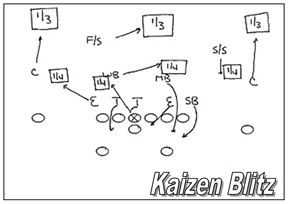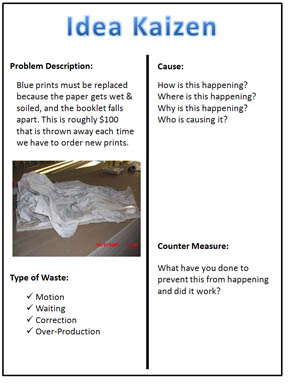 We’ve initiated a Kaizen Blitz several times this year to collect information for PDCAs. In the past, the leader of a PDCA group casually emailed a question to Teammates. The responding Kaizens, generally, were a few sentences describing a possible counter measure.
We’ve initiated a Kaizen Blitz several times this year to collect information for PDCAs. In the past, the leader of a PDCA group casually emailed a question to Teammates. The responding Kaizens, generally, were a few sentences describing a possible counter measure.
For a construction PDCA initiated last week, the group leader and I decided to hit the pause button and examine our Kaizen Blitz process more closely .
This PDCA is looking into a recurring waste in which jobsite blue prints are replaced at least once if not multiple times during the construction of the home. This is costing them roughly $100 per replacement. And the PDCA group wants to initiate a Kaizen Blitz to collect info about the recurrence of this problem across all communities.
That brought us to the purpose of a Kaizen Blitz. The PDCA group first had to define their objectives:
a) How many other communities are experiencing this waste and what are the details?
b) Are communities that are not experiencing this problem doing something that the others aren’t?
 So our experiment began with the PDCA group setting up a Kaizen for every member of the Construction Team. In this Kaizen, the problem description was clear and concise and included a photograph of a wet, tattered set of blue prints that would now have to be thrown away. (That’s $100 in the trash, and another $100 for a new set of prints.)
So our experiment began with the PDCA group setting up a Kaizen for every member of the Construction Team. In this Kaizen, the problem description was clear and concise and included a photograph of a wet, tattered set of blue prints that would now have to be thrown away. (That’s $100 in the trash, and another $100 for a new set of prints.)
Rather than a casual email, the PDCA group gave the Construction Team information to build a worthwhile Kaizen. Next the PDCA group leader wanted to ensure the Construction Team understood the group’s expectations.
He said he wanted each Construction Professional to put some thought into what they see in their environment, then write a thought-out explanation for causes and counter measures. That led us to the next step.
In the Kaizen we set-up for the Construction Team, the PDCA group pre-set questions in the root cause and counter measure fields. For the root cause, they asked the Construction Professional to fill-in the “why, where and who.” Then in the counter measure field, they asked, “What have you done to prevent this and did it work?”
Some Construction Professionals may only be able to answer one section and not the other. That’s okay. If a community is experiencing blue print re-order waste, the Construction Professional should be able to point where and why he sees it happening, even if he’s not sure what to do about it. Another community that isn’t experiencing this waste may be taking preventative steps without fully realizing why. (“If it ain’t broke, don’t fix it.”)
Finally, this Kaizen Blitz should achieve something that no other blitz has managed to achieve: 100% participation. Past Kaizen Blitz have always had strong participation, but generally if a Construction Professional doesn’t have that problem in his community or has no ideas for a counter measure – even if he’s experiencing the problem — he doesn’t participate in the Kaizen Blitz.
Because this PDCA group set-up a Kaizen for every member of the Construction Team and set clear expectations, they are expecting feedback from 100% of the team.
© October 2009 Homebuilding Partners, Inc.
I had a couple of Idea Kaizens to contribute in this blitz. Having the problem description and a photograph pre-set in the Kaizen helped me get to the point. I didn’t have to put in a lot of time trying to figure out what the group was trying to do.
There’s been some discussion about whether or not having a pre-set problem description and pre-set questions in the causes/counter measure fields would be kind of like “leading the witness” but as long as those questions remain “who/what/where/why/etc” I think it’s fine.
By: Chad Pitts on October 13, 2009
at 2:32 am
I like the Idea Kaizen set up for me in the ways of the problem statement. But i feel it was steering me towards a solution. In this pdca, the solution seems simple, protect the plans from the elements and all is fine. But do we run the risk of beta error by someone else putting thoughts in our heads?
If its a more complex problem I believe we will. If the Idea Kaizen is setup for us, the problem is laid out and we are expected to throw in some root causes and some countermeasures. If all you are looking for is Idea’s great, but a solution may be mountain jumping. We just need to be careful in how we use this process.
By: Adam Mays on October 13, 2009
at 12:27 pm
Agreed Chad. I like the idea of a pre-set blitz. It assures the focus of the problem solving blitz. The only criticsm I have is the that the request itself didnt catch my eye on my IK home page. Although it was at the top, if I had just finished a few IK’s of my own then I might have never seen the invite. Maybe a simple fix like using all caps or anything to grasp our attention. Other than that I think all blitz’s should be done this way.
By: Adam Roller on October 13, 2009
at 2:07 pm
I definitely think this is a better way to do our Kaizen Blitz than the old way because for one it’s removing a step for the PDCA Leader. Instead of us peice-mailing him info, all our data and info is in one Kaizen. And two the answers are much more detailed because of the process.
By: Josh Ellerbee on October 14, 2009
at 1:11 pm
Yes, this is a better way. It puts all the thinking in front of you.
By: Charles Allen on October 15, 2009
at 3:55 am
I look at the start matrix to see what floor plans will be coming up and I have the PP order me extra prints for that design so that I can use them as the jobsite copy. The stamped print I only bring out for inspections so the inspector has a new, clean and legible print to see.
Through this process I have never had to order stamped prints because they were damaged or lost. The inspectors like clean prints when they come to inspect so that they are not piecing ripped sheets together or looking through dirty handprints.
By: Guy Frankenfield on October 15, 2009
at 10:16 am
The pre-set problem staement is beneficial during the Kaizen Blitz session. The problem statement is carefully thought out by the team, this reduces the amount of confusion and will help in the data gathering process. The participant in the Blitz now has a clear understanding of the problem and is on board with the team leader. The team leader benefites from the pre-set problem statement by having all the participants on the same page during the process. The Kaizen Blitz process opens the dialogue between the team and the participants, by helping the team determine the root cause and countermeasures.
By: Ivan Gudelj on October 15, 2009
at 2:33 pm
I am torn on this one – I feel it is leading but on the other hand it sets clear direction on what information the group is looking for. I would like to see a couple more blitzes done this way just to see if I still feel ‘lead’ to the answer.
By: Amy on October 16, 2009
at 12:31 pm
First, congratulations on hitting the pause button. So few organizations do that. They just power through something that isn’t working hoping it just works itself out by itself.
Second, I don’t think “leading the witness” is a bad idea. Being completely unconstrained often leads to less creativity than working within limits. As long as you aren’t leading towards a pre-determined answer but instead to a line of thought, I think it is helpful.
Jamie Flinchbaugh
http://www.jamieflinchbaugh.com
By: Jamie Flinchbaugh on October 17, 2009
at 4:32 pm
I would like to see more blitzes tried this way before I will have a decent assessment on this approach. For the fist attempt, having the pre-filled out information sure helped with being able to focus on the problem, especially when giving an opinion on something.
Having it pre-filled allows for more creativity, since one almost doesn’t have to focus so much on mechanics and where they’ll get a picture, etc. I like it. I vote that we try it again.
By: Cameron Coe on October 19, 2009
at 11:31 am
As the team leader for this PDCA, I feel this kaizen blitz has been the most successful out of all the blitzes we have done before. It gives me all the data i need to put together the PDCA. I feel it is imperative a picture is attached to the blitz if we continue to set it up this way. From reading all the kaizen responses it didnt seem like anyone was led to an answer. There were several different responses but they all stayed on the path that was set up.
I agree with Amy and would like to see this format piloted a couple more times to see if the leaders of the other PDCA groups experience the same kind of success in data collection as i did.
By: Mike Macaluso on October 19, 2009
at 8:19 pm
[…] A New Strategy for the Kaizen Blitz from Lean Homebuilding – on PDCA, kaizen, with lots of good comments […]
By: Curious Cat Management Improvement Blog » Management Improvement Carnival #80 on November 3, 2009
at 8:48 am